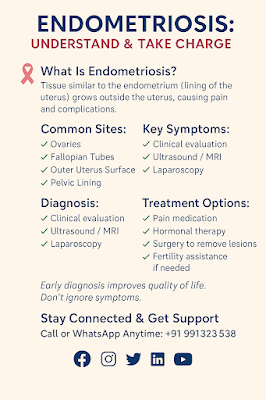🎀 Endometriosis: Understanding, Managing, and Overcoming This Common Women’s Health Condition
Endometriosis is a chronic gynecological condition that affects an estimated 10% of women of reproductive age worldwide. Despite being so common, it often goes undiagnosed for years because many people think severe menstrual pain is “normal.”
This article will help you understand what endometriosis is, why it happens, how it is diagnosed, and what you can do to manage it.
🌸 What is Endometriosis?
Endometriosis occurs when tissue similar to the lining of your uterus (endometrium) grows outside the uterus. This tissue can be found on:
✅ Ovaries
✅ Fallopian tubes
✅ The outer surface of the uterus
✅ Ligaments supporting the uterus
✅ The pelvic lining (peritoneum)
✅ In rare cases, even on the bladder, intestines, or other organs
Every month, this tissue thickens, breaks down, and bleeds, just like the normal endometrium inside the uterus. However, because it has no way to exit the body, it becomes trapped. Over time, this process causes:
🔹 Inflammation and irritation
🔹 Scar tissue formation (fibrosis)
🔹 Adhesions—tissue bands that bind organs together
⚠️ What Causes Endometriosis?
The exact cause isn’t fully understood, but several factors are thought to contribute:
🔹 Retrograde menstruation: Menstrual blood flows backward through the fallopian tubes into the pelvic cavity instead of leaving the body.
🔹 Immune system disorders: An impaired immune system may fail to recognize and destroy endometrial-like tissue outside the uterus.
🔹 Hormonal factors: Estrogen promotes the growth of this misplaced tissue.
🔹 Genetics: Endometriosis often runs in families.
🔹 Surgical scar implantation: After surgeries like C-sections or hysterectomies, endometrial cells may attach to the incision site.
👀 Common Symptoms of Endometriosis
Symptoms vary, but the most common include:
🔹 Severe menstrual cramps that don’t improve with usual painkillers
🔹 Pain during or after intercourse
🔹 Chronic pelvic or lower back pain
🔹 Heavy periods (menorrhagia) or bleeding between periods
🔹 Pain with bowel movements or urination, especially during menstruation
🔹 Infertility (up to 40% of women with infertility have endometriosis)
🔹 Fatigue, bloating, diarrhea, or constipation
Some women have mild endometriosis with severe symptoms, while others have advanced disease but little discomfort.
🩺 How is Endometriosis Diagnosed?
Diagnosis often takes years because symptoms can mimic other conditions like pelvic inflammatory disease or irritable bowel syndrome.
If you suspect endometriosis, see a gynecologist. Your evaluation may include:
✅ Detailed medical history and symptom review
✅ Pelvic exam to feel for cysts or tender nodules
✅ Imaging tests:
-
Ultrasound: Helps identify ovarian endometriomas (“chocolate cysts”)
-
MRI: Useful for detailed mapping
✅ Laparoscopy (minimally invasive surgery): -
A thin camera inserted into your abdomen to directly visualize and biopsy the lesions
-
This is considered the gold standard for diagnosis
🌿 Treatment Options for Endometriosis
Treatment depends on the severity of symptoms, age, fertility goals, and overall health. Options include:
🔹 Medication
-
NSAIDs (pain relievers): Ibuprofen, diclofenac for cramp relief
-
Hormonal therapy: Birth control pills, progesterone-only pills, hormonal IUDs, GnRH agonists to suppress periods and shrink lesions
🔹 Surgery
-
Laparoscopic excision or ablation to remove endometrial implants and scar tissue
-
Hysterectomy (removal of the uterus): In severe cases when other treatments fail and fertility is no longer desired
🔹 Fertility Treatment
-
If conception is difficult, options include ovulation induction, IVF, or assisted reproductive technologies
💛 Self-Care and Lifestyle Tips
While medical care is essential, you can also support your health by:
✅ Eating an anti-inflammatory diet (fruits, vegetables, whole grains, omega-3 fatty acids)
✅ Staying active—gentle exercise may help reduce pain
✅ Practicing relaxation techniques (yoga, meditation, breathing exercises)
✅ Applying warm compresses to ease cramps
✅ Tracking symptoms to understand flare-ups
💬 Emotional and Social Impact
Endometriosis can be physically and emotionally draining. It may affect relationships, work productivity, and mental health. You are not alone.
Seek support from:
-
Counseling or therapy
-
Support groups
-
Patient advocacy organizations
📞 Get Help Today
If you experience symptoms, do not ignore them. Early diagnosis and treatment can improve your well-being and fertility outcomes.
For appointments, consultation, or support, Call or WhatsApp us anytime:
📞 +91 9913233538
🔗 Connect With Us
Stay updated and learn more about women’s health:
👍 Facebook
📸 Instagram
🐦 Twitter
💼 LinkedIn
▶️ YouTube
✨ Hashtags
#EndometriosisAwareness #WomensHealth #Gynaecology #HarshHospital #EndometriosisTreatment #KnowTheSigns #HealthEducation #EmpowerWomen





No comments:
Post a Comment